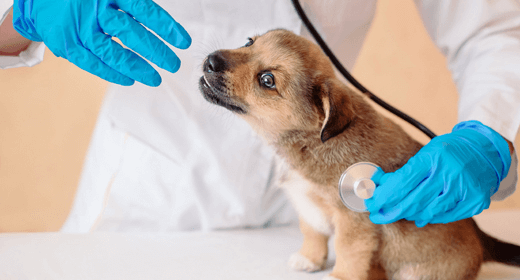

Your puppy's first visit to the vet will probably be more than just a quick hello. Get all the details from Veterinarian Dr. Katy Nelson as she talks about important details like how to properly bring your puppy into the vet's office and vaccinations he needs.
Your puppy's first veterinary checkup is about much more than simply greeting your dog's new vet, weighing in, and getting him his standard immunizations. Believe it or not, your first visit is just as much about educating yourself and answering your questions as it is about checking the health of your newest family member. Your first vet visit requires organization, preparation, and sometimes even some light note taking. Hi, I'm Dr. Katy Nelson with IAMS, and today we're talking about how to take your new puppy to his first veterinary appointment. Let's begin with what you'll need to bring to your first visit. First, you should find out what the breeder or shelter has already done for your puppy. They've probably given them some vaccinations. He probably has also been placed on a deworming schedule, and may even be on a heartworm preventative. And depending upon his breed, the tail may have been docked and the dewclaws removed. Your veterinarian will need all of this information, along with the puppy's approximate birth date. So it's important to bring all of your paperwork with you to your first veterinarian visit, so they can help you determine a schedule for completing immunizations, and determine when it's best to schedule spaying and neutering. Next you should bring a fresh stool sample to your first visit, so the veterinarian can check for parasites. Lastly, prepare a list of questions. After having your puppy home for a few days, there's no better time to ask questions than at your first visit with a medical professional. Ask other family members, too, if they have any questions that they'd like added to your list. Once you're prepared, bring your puppy's crate to the car, and do your best to secure it with available seat belts. Depending on the size and weight of the crate and the puppy, it's usually easier to secure the crate first, and then put your puppy inside. If you cannot fit a crate in your car, try purchasing a dog seat belt that is specifically designed to restrain and protect your puppy in case of an accident. This next piece of information is critical. Carry your puppy into the doctor's office. Do not let him interact with any other animals in the office. Though the other animals may be perfectly healthy themselves, your puppy can still get very sick from even just rubbing noses with another dog until his vaccinations and immunity against disease is further developed. After greeting you and your new pup, your vet will likely begin examining your pup as she continues to converse and answer your questions. She'll check your puppy's weight, temperature, heart, lungs, ears, genitals, eyes, nose, skin, anal region, mouth, and gums for both basic and breed abnormalities. Your puppy needs to learn to be comfortable being handled by others. Remaining calm and peaceful in the new environment with the vet or any other stranger will allow your puppy to do the same. Depending on the status of your puppy's records and stool exam, your puppy will also begin the deworming process, receive the following initial vaccines: rabies, distemper, and Bordatella. If your puppy's exposed to other dogs in boarding, public dog parks, training, and other situations, then based on geography and lifestyle, ask your veterinarian which vaccines they recommend for your puppy. Also, ask your vet about microchipping, and when it is safe to begin socializing and training your pup. Following the initial visit, your veterinarian will ask that you return to booster the vaccines until your puppy reaches a certain age. The time between boosters typically ranges between two and four weeks. Here are some signs that your puppy needs immediate medical care: allergic reactions or swelling around the face, hives-- this is most easily seen on the belly or face-- any eye injuries, any respiratory problems, any signs of pain-- panting, labored breathing, increased body temperature, lethargy, restlessness, or loss of appetite-- any suspected poisoning, any open wound, a seizure, fainting, or collapse, snake bites, thermal stress-- either too hot or too cold-- trauma, like if he's hit by a car, even if he seems fine, vomiting or diarrhea more than two or three times within an hour. I'm Dr. Katy Nelson with IAMS, and I hope that you found this helpful as you welcome your new addition to the family.


Rabies is one of the most serious health risks every pet parent must be aware of. In puppies primarily, this disease can manifest itself in particularly severe forms and often goes undiagnosed until it has already progressed to its later stages. Understanding the signs and symptoms of rabies in puppies can help you act as quickly as possible if your beloved pup ever becomes infected with this potentially fatal virus. Please continue reading to learn more about what rabies is, how it presents itself on a physical level, and which treatments may help save the lives of affected puppies.
Rabies is a viral infection that affects the nervous system of animals, including humans. It is transmitted through the saliva of an infected animal, usually through a bite or scratch. Symptoms include fever, headache, muscle spasms, and paralysis. If left untreated, it can lead to coma and death. Vaccination is the most effective way to prevent rabies.
Puppies can contract rabies just like any other animal, but they are generally not at high risk for it unless they are exposed to a rabid animal or live in an area where rabies is prevalent.
It is important to be aware of the signs of rabies in puppies so that you can take the necessary steps to protect your furry friend from this lethal virus. Some of the most common symptoms of rabies in puppies include:
These behavioural changes are often the first sign that rabies may be present in a puppy. Caregivers should watch for any aggressive behaviours or if their normally outgoing puppy appears withdrawn or unusually timid.
Suppose a puppy begins to lose its appetite or has trouble drinking water. In that case, this can indicate that it is infected with rabies.
Rabies can make a puppy appear disoriented and cause them to stumble when they walk.
A puppy infected with rabies may have difficulty controlling its muscles and suffer from paralysis in some areas of the body.
This is one of the more noticeable signs of rabies in puppies and is caused by the virus paralyzing the muscles controlling swallowing.
Puppies infected with rabies may make different sounds when barking or growling, such as a higher-pitched tone or a more strained voice quality.
Puppies with rabies may be overly fearful of water, even if they usually enjoy swimming or walking by the river.
Rabies can cause violent tremors and seizures, which can indicate the virus.
A puppy infected with rabies may have difficulty breathing as well as experience a choking sensation.
Rabies is a fatal virus that can cause the nervous system's deterioration, leading to death in some cases.
Pet owners must be aware of these signs of rabies in puppies, so they can seek immediate medical attention if their pet shows any of the symptoms listed above.
Several factors can contribute to rabies in puppies, such as:
Rabies is a viral infection that can be transmitted through the bite of an infected animal such as a bat, raccoon, skunk, or fox. Scratches from an infected animal too can cause rabies.
Rabies can also be transmitted through contact with an infected animal's saliva such as through a lick from an infected animal.
Occasionally, rabies can be transmitted from an infected mother to her puppies before or during birth.
Puppies that have not been vaccinated against rabies are at higher risk of contracting the disease.
Poorly maintained or unsanitary living conditions can increase the risk of puppies contracting rabies.
It is essential to get your puppy vaccinated against rabies as soon as possible. This disease can be fatal if not treated promptly and can also be transmitted to humans.
To prevent rabies, your puppy should receive a series of vaccinations at the following ages:
It is also important to keep your puppy up to date on all other vaccinations, including those for distemper, parvovirus, and hepatitis.
Before vaccinating your puppy, check with your veterinarian to determine the best vaccination schedule. Your veterinarian will also be able to provide you with more information on the risks and benefits of vaccination.
While vaccination is the ultimate prevention for your puppy, here are a few additional steps you can take to keep rabies at bay:
Rabies can be transmitted through bites or scratches from infected animals. Therefore, it is important to keep puppies away from wild animals, especially stray dogs and cats.
This will help prevent them from coming into contact with wild animals and other dogs infected with rabies.
Symptoms of rabies in puppies include lethargy, fever, loss of appetite, and changes in behaviour. If any of these symptoms are observed, it is crucial to contact a veterinarian immediately for further evaluation and treatment.
This will prevent them from coming into contact with wild animals and other dogs infected with rabies. If you must take puppies outside, supervise them closely and keep them on a leash.
Although rare, the possibility is real. To protect against this potentially fatal virus and quell any worries you may have, get your furry friend vaccinated with a rabies shot as soon as possible! If you are still concerned about their health after the vaccine, don't hesitate to consult a trusted veterinarian for advice.